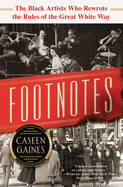
In 2016, Broadway saw an unusual revival: Shuffle Along, or, the Making of the Musical Sensation of 1921 and All That Followed. Back in 1921, as now, many high-profile theatrical productions featured the stories of white characters, played mainly by white actors, but both the original Shuffle Along and its revival offered something different. The musical revue, created by two comedians and a pair of accomplished musicians, was the first all-Black musical comedy to make it big on Broadway, and its success had far-reaching effects on race relations in the entertainment industry. In vivid and lively prose, author, teacher and pop culture historian Caseen Gaines digs into the history and impact of Shuffle Along and its creators in his engrossing, meticulously researched fifth book, Footnotes: The Black Artists Who Rewrote the Rules of the Great White Way.
Gaines (We Don't Need Roads) begins with a pivotal moment from the show's 1921 opening night: "Love Will Find a Way," a duet performed by two of Shuffle Along's Black characters. In vaudeville and across the entertainment industry, Black actors were often forced to play stereotypes for laughs, feeding white audiences familiar jokes about uneducated "Negroes" who couldn't do simple math or string together a coherent sentence. While the plot of Shuffle Along (involving a crooked mayoral race) did include some of these moments, the show also gave its Black actors, musicians and dancers a chance to perform at a greater dramatic range. But the show's creators feared that white audiences would not accept a song, much less an entire show, that portrayed Black people as complex human beings capable of real thoughts and feelings.
To everyone's surprise, the audience not only enjoyed the syncopated jazz music and genuine love story, but roared for more, kicking off Shuffle Along's successful run on Broadway and its subsequent national tour. The show was plagued by constant financial troubles, though: the cast often went without pay, and the showrunners struggled to meet travel costs and other expenses. The economic and social effects of World War I, Prohibition and the Great Migration of Black Americans to northern states--among other forces--also affected the show's fortunes. But for its creators and participants, it helped form a vision for what was possible: a future America where Black actors could play authentic roles rather than squeezing themselves into narrow stereotypical boxes.
Footnotes is the story of one musical, but it is also a group biography of four men who were only one generation removed from slavery, whose lives and careers spanned rapidly changing times. Gaines charts the personal histories of the show's architects: comedians Flournoy Miller and Aubrey Lyles, and musicians Noble Sissle and Eubie Blake. He delves into each man's origin and career, recounting the success Miller and Lyles found together in vaudeville, and the musical adventures of Sissle and Blake, which took them from New York's jazz venues to playing at French military bases during World War I. Though none of the four had ever written a musical or performed on Broadway, they teamed up to conceive (and find funding for) something entirely new with Shuffle Along. They rented a theater on West 63rd Street--not in Manhattan's theater district, but close enough--and hammered out a book and a score that fused comedy, jazz, romance and plenty of dancing. The show would go on to launch the careers of performers--among them Florence Mills, Paul Robeson and a very young Josephine Baker--as well as open doors for many of its other cast, crew and orchestra members.
Drawing on extensive historical and archival research, Gaines holds up the show's creators as examples of Black excellence in a world designed to trap them in failure. He captures their complicated experiences and interpersonal dynamics, and draws sharp contrasts between the treatment of Black people in the U.S. and the accolades they received abroad. He also records the showrunners' struggles along with their triumphs: the way the show never quite managed to balance its books, the moments where the show's actors and writers resorted to blackface to get a laugh from the audience, the blatant colorism (onstage and off) that elevated light-skinned Black people above their darker counterparts. Judged by the standards of today, much of the show's original script reads as tone-deaf or even offensive. But a century ago, the musical provided a mix of satire, genuine emotion and familiar (if shopworn) jokes that drew in audiences and kept the show touring until 1924.
The book's last chapters deal with the show's several revivals, most of which were unsuccessful (until the 2016 remake) and the later careers of the showrunners. Gaines also muses on the ways in which Black actors and artists have still struggled to make a home for themselves on Broadway. In a moment of national conversation about systemic racism in the U.S., the story of Footnotes is not only compelling but perfectly timed. --Katie Noah Gibson

